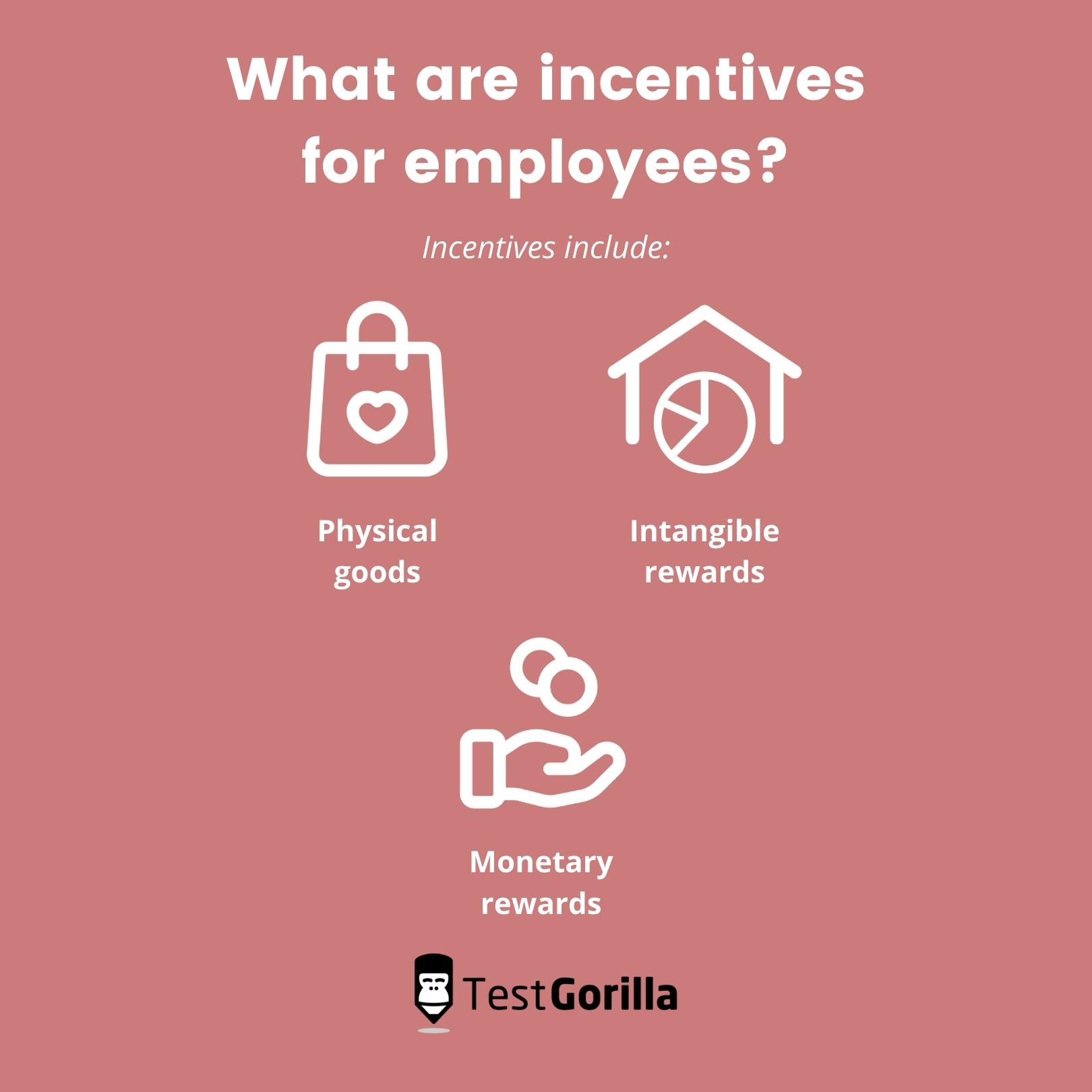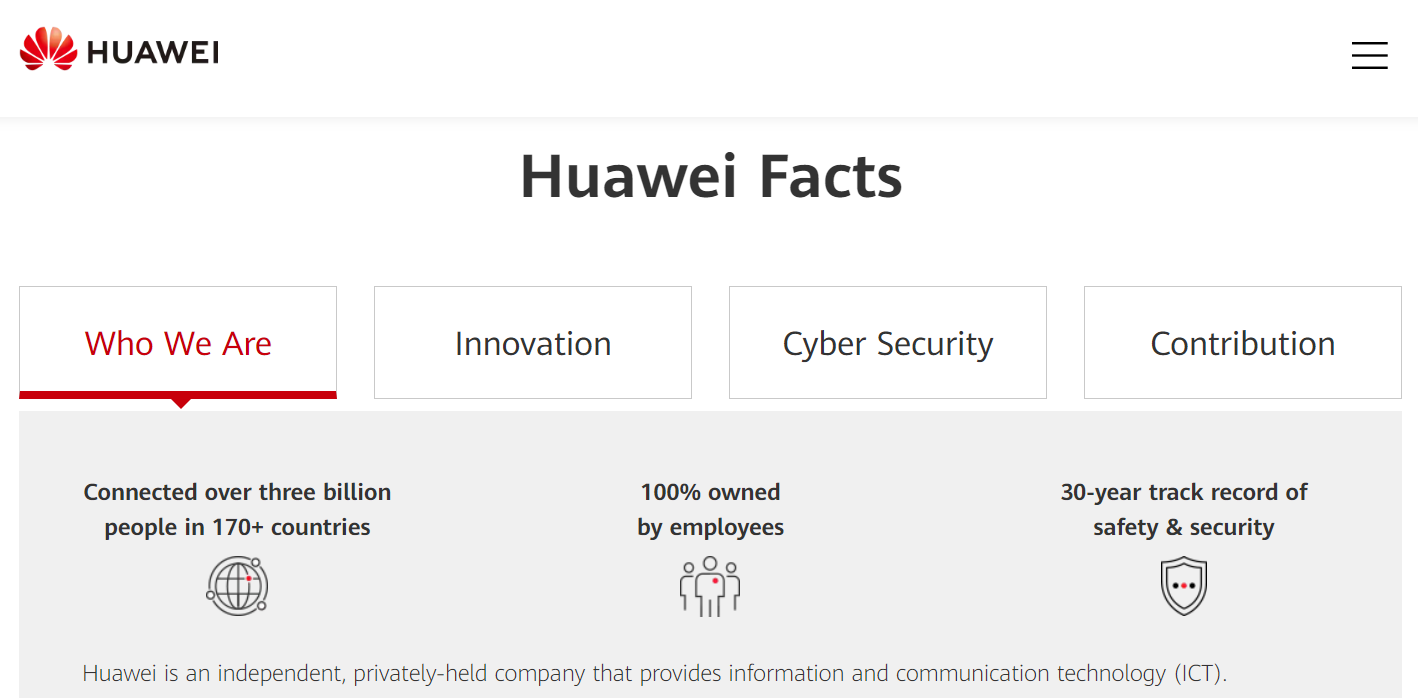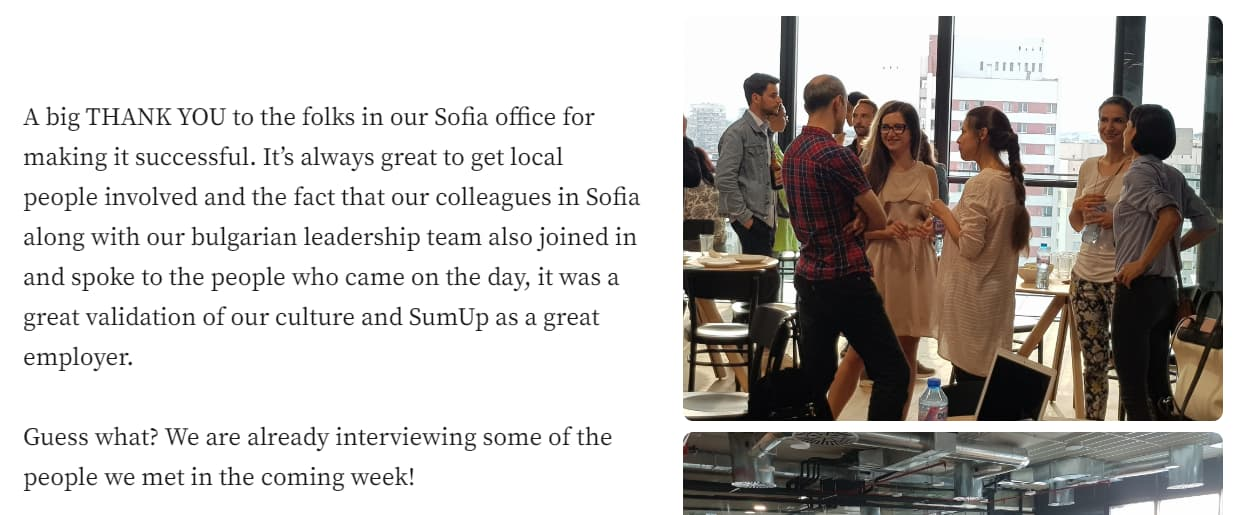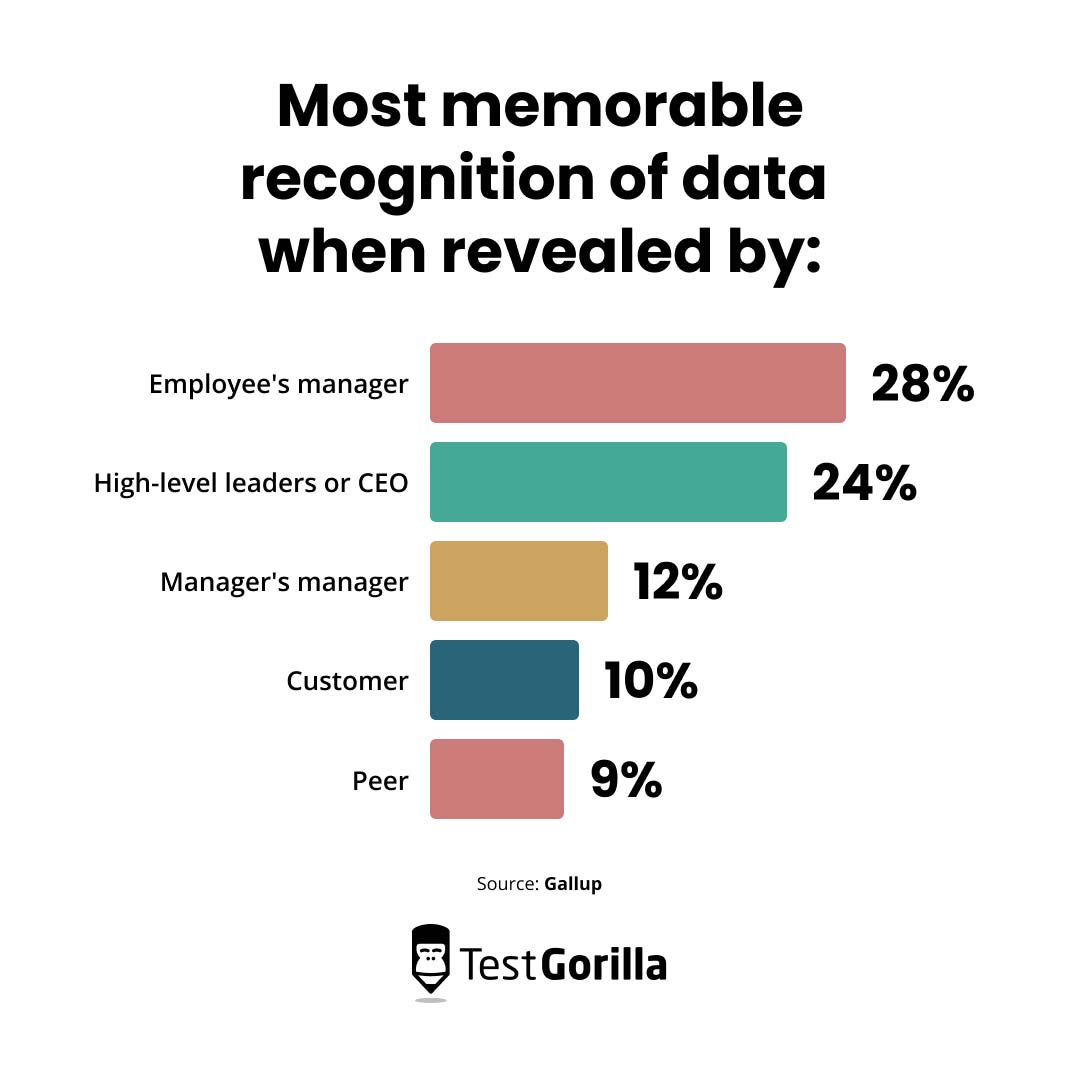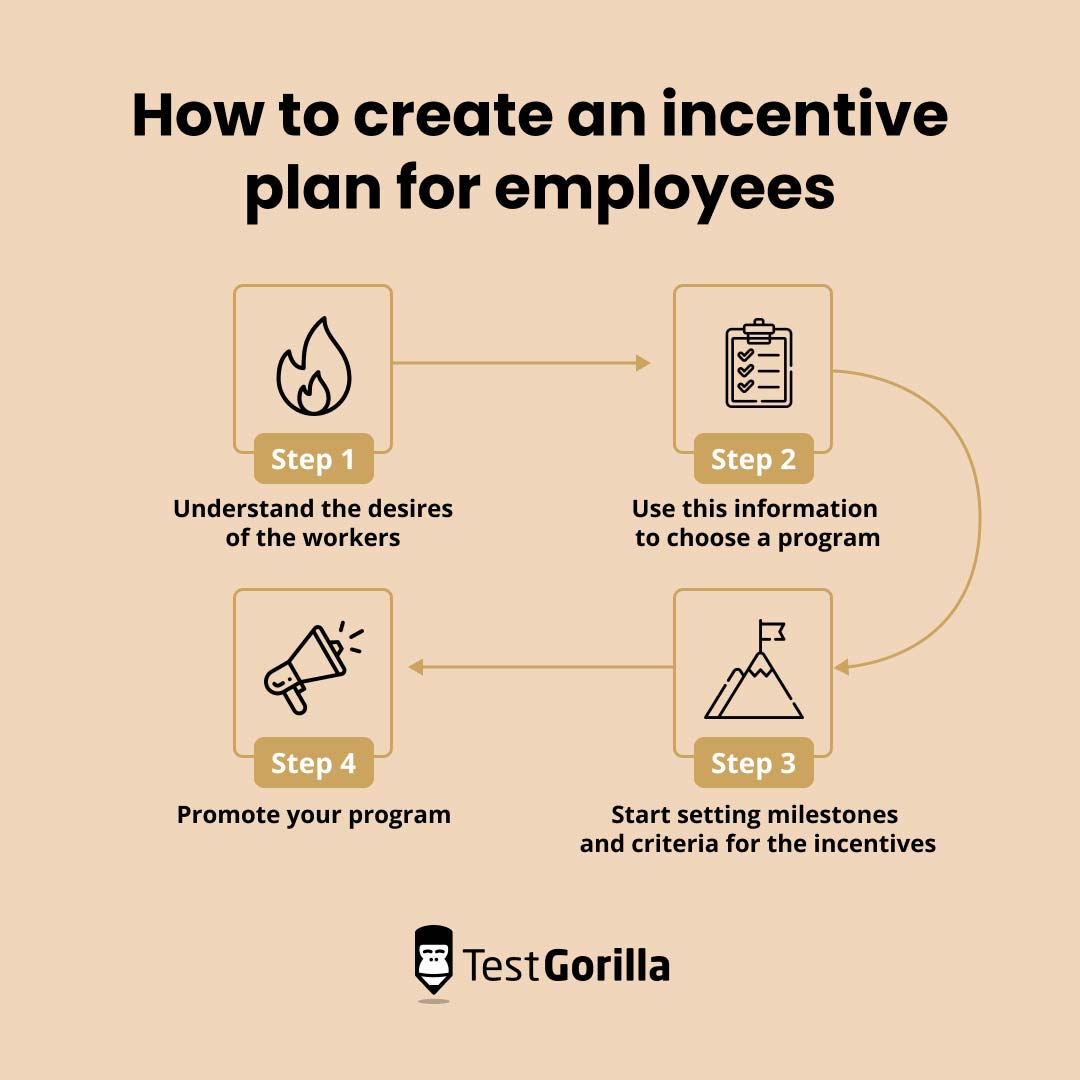Employee incentive programs: 15 ideas to boost engagement and retention [plus 7 best practices]
Great news – one of your team members has been doing brilliant work, so you offer them one of your employee motivation incentives to keep it up.
There’s just one problem: Your employee incentive programs don’t work for them.
Maybe you’re offering a coupon for a romantic dinner, but they’re proudly single, or they’re a remote employee, and you deliver free donuts and coffee to the office.
If it’s the thought that counts, your organization hasn’t thought at all about what the employee wants or needs. It might even be enough to drive them back into the job market.
As an employer, offering the right rewards with employee incentive programs is essential to reap their benefits: higher engagement and reduced turnover.
In this blog, we explore how to provide the right incentive for employees through a targeted employee incentive program, including 15 ideas for employee incentive programs and seven best practices to follow.
Table of contents
- What are employee incentives?
- What are employee incentive programs?
- The benefits of employee incentive programs
- 8 monetary employee incentive programs that improve engagement, performance, and retention
- 7 non-monetary employee incentive programs that improve engagement, performance, and retention
- 7 best practices for designing the perfect employee incentive program
- An example of how to create an incentive plan for employees
- Use a skills-based approach to design and implement effective employee incentive programs
What are employee incentives?
Employee incentives are any type of reward aimed at boosting productivity, performance, and retention.
Possible incentives for employee engagement include:
Physical goods, such as gift baskets
Intangible rewards, such as employee recognition
Monetary rewards, such as gift cards and bonus cash incentives
What are employee incentive programs?
Employee incentive programs are the formalized processes by which employers award incentives to their employees.
One example is an employee referral bonus. In this case, the employee incentive program is the referral scheme that stipulates:
How these bonuses are calculated
Which roles are eligible
What the requirements are
Creating an employee incentive plan streamlines the rewards process and enables you to track the return on investment for your employee incentive programs.
The best insights on HR and recruitment, delivered to your inbox.
Biweekly updates. No spam. Unsubscribe any time.
The benefits of employee incentive programs
Employee incentive programs increase engagement by providing motivation for employees to invest more time and effort in their jobs.
This is necessary because employee engagement is trending downward, dropping from 36% in 2020 to 32% in 2022.
As well as improving engagement, employee incentive programs also help in other areas:
Employee morale and team-building. Happier workers collaborate well together; it’s not rocket science!
Productivity and performance. A study by Gartner showed that a recognition and rewards program can drive an 11.1% increase in employee performance.[1]
Loyalty and retention rates. When employees are recognized at work, they are statistically unlikely to look for a new job in the next three to six months.[2]
There are also practical benefits of employee incentive programs as a strategy for managing organizational health:
They can easily be applied to remote work employees. Many of the strategies below are remote-friendly.
They are easy to customize to suit every industry, organization, and worker.
They don’t just offer incentives for employee retention; they attract top talent. Two-thirds of candidates say that benefits packages are a must-have when selecting a new employer.[3]
Incentive programs fall into two categories: monetary and non-monetary.
Next, we discuss 15 types of employee incentive programs, along with their pros and cons.
8 monetary employee incentive programs that improve engagement, performance, and retention
Certain employee reward programs are desirable in theory, but a large number of employees never use them or just don’t care for them.
For example, physical gifts aren’t always good employee motivation incentives for remote workers, and they can seem impersonal since they are typically given by distant employers.
You need to choose your employee incentive program wisely. Here are 8 employee incentive ideas that provide financial incentives for employees.
8 monetary employee incentive programs to improve organizational health: Summary table
In a rush and just want the headlines? Here’s a summary of the pros and cons of each type of employee incentive program.
Employee incentive program examples | Pros | Cons |
1. Bonuses and raises | Financial incentives are tied to motivation | They raise expectations and aren’t possible to ensure year after year |
2. Commission programs | Commissions are easy to calculate and likely to get results | They only work in stable industries like real estate |
3. Profit sharing | Taking part of the profit instills loyalty in employees and aligns them with company goals | Profit sharing has the potential to cause entitlement and jealousy |
4. Referral programs | Referrals can help you obtain high-quality hires and encourage camaraderie | Relying on employees for referrals leads to biased recommendations |
5. Tuition reimbursement programs | Putting employees through college invests in the skills you need to meet your targets | Employees could take the training and walk away |
6. Support their causes and charities | Showing support for employees’ passions promotes a sense of purpose in mission-driven organizations | Employees may not use it, and it’s hard to measure its impact |
7. Discount programs | Discounts can be targeted to specific outcomes, such as getting employees to return to the office | Employees have to spend money to get the reward, diminishing its perceived value |
8. Spot awards | Awarding employees on the spot shows you’re on the lookout for good work and ready to reward it accordingly | Spot awards are susceptible to bias because it’s down to managers’ discretion |
1. Bonuses and raises
Boosting employee compensation by awarding bonuses and raises is possibly the most common employee recognition program out there.
A bonus is a one-time monetary reward. Bonuses can be given for numerous reasons, including:
Signing an employment contract
Completing an important project
Being a top performer
Staying with the company for a certain amount of time
Raises are a permanent increase in pay, so they’re rarer and more selective, usually given only for significant changes in position or duties. Some business owners offer raises depending on the results of annual performance reviews.
Pros and cons
The main benefit of offering bonuses and raises is that it directly answers one of the main reasons for employee attrition: 36% of people who quit their jobs do so due to inadequate compensation.
The disadvantage is that bonuses elevate employees’ expectations.
If top performers get bonuses for selling X number of products one year, they may expect them to reach the same level of performance the next year, which might not be sustainable if higher sales targets need to be met.
Example
The airline company EasyJet needed to bolster its numbers after a dramatic employee drop from the onset of the COVID-19 pandemic. The airline therefore offered a $1,225 sign-on bonus to help attract talent before the busy summer season.[4]
2. Commission programs
Commission programs are commonly used to incentivize sales teams. They award a percentage of each sale – a commission – to the salesperson who secures it.
Some salespeople work purely on commission, with all their income coming directly from sales. Others have a base salary on which commission is added.
Pros and cons
Commissions are easy to calculate and likely to get results. Commission-only employees are also only paid when the revenue they bring in is secured.
However, you may see high turnover with a commission-only compensation structure if salespeople need to leave to pursue more security elsewhere. This model, therefore, only works in fairly stable markets where sales are consistent.
Example
Commission programs are common in real estate, usually between 5% and 6% of a sale.
On the sale of a $400,000 house, a broker charging a 5% commission would receive $20,000. This is usually split 50/50 between the listing broker and the buyer’s broker, giving $10,000 to the brokerage.
3. Profit sharing
A profit-sharing plan gives employees a percentage of the company’s profits. This might be paid quarterly or yearly, or as a lump sum when employees retire.
Pros and cons
Profit sharing provides employees with a sense of ownership in the business. Offering stock options is also an effective way to do this.
However, this can be costly. You are, after all, giving away a percentage of your profits to employees when this money might otherwise be reinvested in your business.
It may also breed resentment among employees outside the program, so it’s best for businesses that can afford to profit share with most or all of their employees.
Example
Huawei, China’s largest telecommunications equipment maker, illustrates profit sharing at its best.
Huawei is 100% employee-owned by more than half of its total staff – 104,572 out of its 194,000 workers.
Its structure turns eligible employees into stakeholders, building a solid, loyal relationship with them and sharing responsibility among the entire workforce.
4. Referral programs
Employee referral programs offer bonuses and perks to employees who refer other people for opportunities at your organization.
Pros and cons
An employee referral program can be a highly effective hiring strategy.
In 2016, referral programs were the top source of hires among businesses, delivering almost a third of all successful candidates.[5]
The main disadvantage of referral programs is that they are unlikely to bring in diverse candidates because employees mainly recommend friends of the same demographic.
Example
SumUp holds employee referral happy hours, taking inspiration from Salesforce.[6]
SumUp asked its employees to invite qualified friends and family to an event with drinks, snacks, and relaxed conversations. The company even set up several interviews with the people in attendance.
5. Tuition reimbursement programs
Through tuition reimbursement programs, employers repay employees for the expense of their continuing education.
Most employers put a cap on how much they spend on tuition reimbursement per employee. The median amount of tuition provided by employers per year is $5,250 for undergraduates and $10,500 for graduates.[7]
Pros and cons
Tuition reimbursement is an effective way to invest in employees’ skills to better meet your company’s needs. It can boost performance as well as employee gratitude.
It’s likely to be a particularly strong incentive for younger workers like Millennials and Gen Z.
In 2023, the average federal student loan debt balance became almost $38,000, rising to nearly $41,000 when you include private loan debt.[8]
However, tuition reimbursement programs also carry the risk of employees taking their advanced skills to another employer. It’s also harder to see the direct impact of these initiatives on your bottom line.
Example
Bank of America expanded its tuition reimbursement program in 2020. The financial institution increased tuition assistance for employees to $7,500 per year (up from $5,250) for a range of academic and professional certifications.[9]
6. Support their causes and charities
With corporate giving programs, employers match an employee’s donation to a charity of their choice or donate on their behalf.
This might be done individually – for instance, if an employee is running a marathon to raise money for charity – or as part of an employee wellbeing strategy involving the whole company.
It can be used as a performance incentive in purpose-driven organizations, or it can be used to incentivize participation in activities that boost your company culture and employer brand.
Pros and cons
Supporting charitable causes works best as an employee incentive program when you align it with your corporate purpose. This makes employees feel closer to your values and more invested in doing good work.
More than 80% of employees believe corporate purpose is important, but less than half think it drives business decisions.[10]
However, not all employees see charitable giving as a worthwhile employee incentive program because they do not feel the benefits directly.
In fact, if you are merely matching employee donations employees wouldn’t have made otherwise, they’re actually losing money. This is why it works best in a highly purpose-driven workforce.
Finally, like tuition reimbursement, it’s hard to see the direct impact of corporate giving on your workforce’s productivity and motivation.
Example
To encourage “volunteerism” in its workforce, ExxonMobil matches employee donations up to $7,500. That applies to not only current full-time employees but part-time and retired workers, too.[11]
7. Discount programs
We’ve all encountered an employee discount program. For consumer companies, these might be discounts on your own products and services, or you might have discount partners, such as local businesses.
Employers can provide discounts to employees through:
Cash-back on online purchases
Digital coupons
Discount codes
Gift cards
Pros and cons
Discounts offer comparable value to employees to cash rewards, but usually at a lower cost to your organization.
These discounts can be aligned with other initiatives to improve workplace wellness. For example, you could provide a discounted local gym membership to promote a healthy lifestyle.
However, because employees still have to spend money to access the reward, they offer less perceived value.
Additionally, if you don’t offer discounts on the right products, employees simply won’t use them.
Example
You could use discount programs to incentivize the return to the office by offering employees discounts on commuting costs and lunches at local businesses.
8. Spot awards
Spot awards, or spot bonuses, are spontaneous rewards for good work, usually when that work requires special effort in a short period.
Among employers, 73% say they offer spot bonuses as one of their employee incentive programs, with the most common industry being tech and IT.
Pros and cons
Because they are given spontaneously, spot awards show your employees that you are on the lookout for hard work and ready to reward it accordingly. The element of surprise may also mean you can make a bigger impact with a smaller amount, such as $50 gift cards.
On the other hand, the spontaneity and subjectivity of spot bonuses make them vulnerable to bias. Men are already almost 10% more likely to get bonuses than women; spot bonuses could exaggerate this disparity.[12]
There is also the risk that without set guidelines, you could over- or under-reward your staff.
Example
The UK banking giant Lloyds gave all employees, excluding senior management, a £1,000 bonus to cover the increased cost of living and to incentivize employees to keep working hard despite turbulence in the economy.[13]
7 non-monetary employee incentive programs that improve engagement, performance, and retention
Monetary employee incentives aren’t your only option.
In fact, the market for non-cash employee incentive programs has grown by 49% since 2016.[14]
Here are seven examples of non-monetary incentive programs you can introduce in your workplace.
7 non-monetary employee incentive programs to improve organizational health: Summary table
Short on time? Here are the basics.
Employee incentive program ideas | Pros | Cons |
1. Social recognition | Recognition is low cost but of high value to employees | It has the potential to cause division and jealousy |
2. Professional development programs | Development meets employee needs for career growth and advancement | It has high cost and time expenditure |
3. Health and wellness perks | Perks can show employees you care about their holistic wellbeing | Not every employee prioritizes health and wellness |
4. Added vacation days or travel incentives | Increased vacation time reduces burnout, especially after a difficult stretch | Frequent time off can take top performers out of action at key times |
5. Gifts or prizes | Gifts given through a points store enable employees to pick what they prefer | A badly-judged gift could leave a worse impression than no reward at all |
6. Team events | Shared experiences boost work ethic and relationships | Events can have a high cost and can eat into productive hours |
7. Choice of future projects | Employees can have a chance to work on their favorite jobs | Star employees may then be unavailable when you need them |
1. Social recognition
Social recognition empowers employees by publicly acknowledging their hard work and achievements.
“Employee of the Month” notices, shout-outs, birthday and work anniversary greetings, acknowledgments, and thank yous all fall under the category of social recognition.
Research has shown that the recognition employees remember most comes from their manager (28%), high-level leaders and chief executive officers (24%), and their manager’s manager (12%).[15]
Pros and cons
Social recognition is a low-cost employee incentive program that brings big personal benefits to your workers.
One study found that 37% of employees consider recognition the most important factor in encouraging them to produce better work more often.
The downside is the possibility of uneven recognition among employees. If others feel that a select few are always in the spotlight, there’s a chance it will cause division and jealousy.
Example
Many businesses now use social media to praise employee achievements. For example, Douglas Scott Recruitment shares testimonials on LinkedIn.
2. Professional development programs
Providing your employees with learning and development opportunities boosts their performance and enhances their overall growth.
The most effective way of doing this is by building professional development plans for employees. For the best results, use skills testing to ascertain which of an employee’s skills need building up.
Pros and cons
Learning and development opportunities are excellent incentives for employees because they appeal to their desires to grow and advance in their careers.
More than 90% of employees would stay with an organization longer if it invested in learning and development.[16]
The disadvantages of this incentive for employees include the time and cost it takes to set up such a reward.
Example
Corey Shott is an engineer at the software company NextRoll. She participated in the “Women in Leadership” workshop, a learning and development opportunity that coaches and trains women to pursue leadership roles.[17]
3. Health and wellness perks
Providing health and wellness support across the board incentivizes employees to join your business. These incentives might include:
Extra time off
Healthy lunches (deliveries if employees work from home)
However, you can also target health and wellness perks to reward high performers or to compensate them for a period of stress after an intense project. You might reward employees for completing a high-intensity project by giving them a coupon for a spa day.
Pros and cons
Providing health and wellness perks lets employees know you care about their overall wellbeing, not just their productivity.
These perks are also something that modern workers want and need:
An average of 25.3% of the US population is physically inactive[18]
Employees are 1.6x more likely to stay with a business that offers wellness programs and benefits
Workers consider a wellness stipend as one of the most important value-added benefits of a company[19]
They also reduce healthcare costs for your organization by averting burnout and encouraging better physical health.
The main disadvantage is that not every employee wants these perks.
Example
You can take inspiration from HRC Recruitment to make the most of your program. It asked its employees what they wanted and designed an incentive program around the responses.
This includes access to YuLife (a wellness app), flexible working options, plus 30 days of annual leave and bank holidays.
4. Added vacation days or travel incentives
One of the most common ways employees reward themselves for hard work is with a vacation; naturally, it’s a great way for you to reward them too.
You could do this by giving high performers extra paid or unpaid vacation days or paying for the vacation in place of a bonus.
Pros and cons
Employees get a tangible, valuable reward for their hard work that doesn’t force their noses back to the grindstone, which makes them feel valued.
It can also be great for recruitment marketing if those who earn a vacation incentive share their employee experiences online.
However, it can be costly, especially if it’s not closely monitored. You also risk taking out high performers from the action at key times for your organization.
Example
A hotel chain might incentivize staff by promising that the five customer-facing staff mentioned in the most reviews on TripAdvisor will win a three-night stay at a hotel of their choice.
5. Gifts or prizes
Employee incentive gifts motivate employees without breaking the bank.
Many organizations give out company swag as employee incentive gifts. You might also award employees points for hitting targets, which they can cash in later for a prize of their choice.
When choosing employee incentive gifts, give employees the ability to choose their prize, such as by awarding spendable points on a company e-commerce site.
Pros and cons
Empowering managers to give out points is an efficient way of incentivizing workers day-to-day.
Research shows that employees who were rewarded with points were more likely to plan how they’d use the reward and discuss it with colleagues.[20]
However, gifts come with their own risks. When gradually building up a collection of points, employees may not automatically draw a connection between their hard work and the prize.
Example
Aurum, a luxury jeweler in the United Kingdom, started a reward points program after a downturn in sales.
The company awarded small amounts of points for simply making a sale, but it gave large amounts of points to top performers and for team efforts.[21]
Sales increased by 3.3%, 183,000 units of high-margin products were sold during the program, and 95% of staff participated.
6. Team events
Team events strengthen peer relationships, foster company loyalty, and reduce stress.
Team event incentives range from lunches, charity events, and karaoke for in-person teams to virtual breakrooms, happy hours, and trivia nights via Zoom for remote employees.
For best results, tie team incentives to team goals. For example, promise a departmental pizza party if they meet their quarterly revenue targets.
Pros and cons
Team events increase bonding, which makes them great incentives for employee engagement. Two out of ten US employees say they have a best friend at work, and researchers project that by increasing this ratio to six out of ten, organizations could:
Reduce safety incidents by 36%
Increase customer engagement by 7%
Boost profits by 12%[22]
This is important: Companies who score in the top quartile for employee engagement are 23% more profitable than those in the bottom quartile.
However, expenditures for gatherings tend to be large, and the impact tends to be short-lived. For that reason, they’re best when scheduled regularly.
Example
Optus, an Australian telecommunications company, won the IMA 2017 Circle of Excellence Award for its Pacesetters Employee Incentive and Rewards Program.[21]
Top performers won a trip to Vietnam, where they were involved in food tours, sightseeing, and charity work.
The team helped build six homes and repaired two schools. This benefited the people who lived in the villages, but it also greatly benefited the employees by giving them a sense of fulfillment.
7. Choice of future projects
This incentive involves giving a top performer the opportunity to pick the project they want to work on.
For example, you could let a project manager choose their next marketing project or a graphic designer pick the client they enjoy designing for the most.
Pros and cons
Giving your staff their choice of future projects fosters trust and loyalty, helping to build a relationship with them.
It also lets them do what they love and what they’re best at. A downside is the possibility of losing a star employee before a challenging upcoming project.
Example
A content marketing company hires a writer who does exceptional work. They impress clients, consistently hit deadlines, and always communicate on time.
As a reward, the business allows them to choose the clients they want to write for in the next month. Happy writer, happy clients.
7 best practices for designing the perfect employee incentive program
We’ve shown you the employee incentive program examples you might draw from for your strategy.
Now, let’s discuss the best practices to use when applying these 15 ideas in your organization.
7 best practices for designing employee incentive programs: Summary table
First up, here’s the abridged version:
Best practice for designing an employee incentive program | Summary |
1. Promote collaboration, not competition | Including teamwork metrics in the evaluation criteria for awards can disincentivize unhealthy competition |
2. Align with company values | Rewarding core competencies sets your organization apart from competitors |
3. Offer an element of personalization | Personalizing your incentives makes employees feel seen and understood |
4. Make it inclusive | Giving all employees equal access to your reward system ensures that they are all equally motivated |
5. Communicate the incentive program to all your employees | Clearly communicating your program through promotion and announcements can help employees take advantage of it |
6. Use the incentives to attract talent | Sharing your rewards and benefits with potential hires makes your company more appealing to applicants |
7. Gather employee feedback | Asking your employees their opinions can help you continuously improve your program |
Now, it’s time to deep dive into each best practice:
1. Promote collaboration, not competition
A good employee incentive program inspires employees to work together for the best results, not work against one another to get prizes.
Where possible, include teamwork metrics in the evaluation criteria for spot awards and other performance-based incentives to ensure that your policies don’t breed workplace conflict.
2. Align with company values
The most effective employee incentive programs are ones that feel authentic for your organization. This means they should reward and nurture the core competencies and traits that set you apart from competitors.
For example, if your culture is built around collaboration, you might provide incentives where employees nominate one another for awards based on teamwork.
They should also align with your mission and overall purpose. Corporate giving is a great place to do this, but inclusive policies are also key here.
3. Offer an element of personalization
Personalization is key when it comes to making employee incentive programs work. Offer a mix of incentives for employees to choose from so that they can select the one that most applies to them. Otherwise, they won’t use it, and you won’t reap the benefits.
Take corporate giving: 30% of employees say that they don’t give through the workplace because the causes they care about are not available as choices.[23]
Talk to your employees about what they want. Hold meetings and evaluate their personalities and skills needs with online tests.
4. Make it inclusive
To ensure that you are motivating every employee, you should design employee incentive programs to include everyone regardless of age, race, gender, or ability.
Prioritizing inclusiveness makes sure everyone on your team is equally motivated and connected to your organization’s mission.
5. Communicate the incentive program to all your employees
Like Alex’s program in our example below, you should make sure to effectively promote your employee incentive plan.
Clearly communicate your incentive plan for employees by holding a kick-off meeting, making a special announcement in your messaging channel, and sending out regular reminder emails.
6. Use the incentives to attract talent
A company with rewards and incentives for employees is attractive to job seekers, so you need to include these in your recruitment strategy.
Make sure to advertise your incentives on your website and in your job ads to let potential hires know about them and keep them front-of-mind when considering you as an employer.
7. Gather employee feedback
Your workforce changes over time; your employee incentive programs need to keep up.
Implement an employee survey to determine the effectiveness of your employee incentive programs and keep track of how many employees participate.
Remember HRC Recruitment’s employee incentive plan we mentioned above? It was based on employee advice and feedback and was subsequently a rousing success.
An example of how to create an incentive plan for employees
Alex is the human resources manager at a SaaS company.
She’s been tasked with specific goals of boosting workplace motivation and creating incentives for employee engagement, not only to improve sales but to acknowledge employee achievement.
She follows a four-step process:
Step 1: Understand the desires of the workers.
This helps determine what your team would consider a perk or reward.
The best incentives for remote employees may be different from those for on-site employees, single employees versus married employees, etc.
Alex gets to know her employees by talking to them, sending surveys, and using online personality and skills tests to discover what would be suitable for every employee.
Step 2: Use this information to choose a program.
Alex chooses wellness programs based on the responses she received. These programs address a range of priorities for employees to provide a well-rounded package.
Benefits for employees | Employee incentive programs |
1. Improving working life and career | Performance raises Employee development program |
2. Improving social life and emotional wellbeing | Supporting their favorite charity Offering paid family leave |
3. Improving physical health and lifestyle | Employee discount to local gyms Free yoga sessions |
Alex considers how sustainable this program will be in the long term. She does this by examining funding stability, organizational capacity, stakeholder partnerships, and more.
Step 3: Start setting milestones and criteria for the incentives
Next, Alex must decide how employees can earn the incentives she’s chosen.
Since quality is the main goal of their SaaS business, Alex prioritizes quality-based awards over quantity-based ones. Instead of “sell X many products,” she uses “increase customer satisfaction by X percent” as a measurement.
The milestones aim to increase engagement and performance, so they should be a balance of challenging, rewarding, and achievable.
Step 4: Promote your program.
Once Alex has designed the program, she then has to promote it and tell her team about it. She could do this in a kick-off meeting or an announcement email.
This is just a quick example of how to reward your staff with employee incentive programs, but you can use this information to put your own plan into action.
Use a skills-based approach to design and implement effective employee incentive programs
When used correctly, employee incentive programs can inspire your workforce to be not only more productive but more collaborative.
The best employee incentive programs are tailored to the needs of your business and the desires of your employees.
This is where talent assessments come in. Together with employee feedback, skills tests help you identify and target the specific development needs of your employees without being swayed by bias.
To find out how to use skills testing to implement employee incentive programs, read our blog about best practices to reward and retain talent.
To learn more about nurturing a positive working environment, read our guide to creating a positive workplace culture.
Or if you’re ready to grow your workforce and want to retain your positive culture, use our Culture Add test to hire the best.
Sources
1. “4 Recognition and Rewards Program Levers for Driving Performance and Engagement”. (March 24, 2020). Gartner Research. Retrieved August 24, 2023. https://www.gartner.com/en/documents/3982467
2. Des Georges, Colette. (2019). “Can employee recognition help you keep them longer?”. SurveyMonkey. Retrieved August 24, 2023. https://www.surveymonkey.com/curiosity/employee-recognition-and-retention/
3. “The Advantages of Employee Care: Creating Human-Centric Employee Experiences and Work Environments”. (2023). MetLife Workforce Insights. Retrieved August 24, 2023. https://www.metlife.com/workforce-insights/
4. Taylor, Chloe. (May 16, 2022). “Airlines offering bonuses of over $1,000 to poach cabin crew in scramble for summer staff”. Fortune. Retrieved August 24, 2023. https://fortune.com/2022/05/16/easyjet-british-airways-bonus-summer-staff-scramble/
5. Maurer, Roy. (June 23, 2017). “Employee Referrals Remain Top Source for Hires”. Society for Human Resource Management. Retrieved August 24, 2023. https://www.shrm.org/resourcesandtools/hr-topics/talent-acquisition/pages/employee-referrals-remains-top-source-hires.aspx
6. “Salesforce.com Now Hiring by Happy Hour”. (March 31, 2014). Wall Street Journal. Retrieved August 24, 2023. https://deloitte.wsj.com/articles/hiring-by-happy-hour-salesforce-com-reinvents-recruiting-1396238539
7. “What Does Tuition Assistance Look Like in 2018?”. (May 29, 2018). TalentCulture. Retrieved August 24, 2023. https://talentculture.com/tuition-assistance-look-like-2018/
8. Hanson, Melanie. (July 17, 2023). “Student Loan Debt Statistics”. Education Data Initiative. Retrieved August 24, 2023. https://educationdata.org/student-loan-debt-statistics
9. “Recent benefit launches and enhancements”. (2020). Bank of America. Retrieved August 24, 2023. https://www.bankofamerica.com/content/documents/employees/launches_and_enhancements.pdf
10. Gast, Arne, et al. (April 22, 2020). “Purpose: Shifting from why to how”. McKinsey & Company. Retrieved August 24, 2023. https://www.mckinsey.com/capabilities/people-and-organizational-performance/our-insights/purpose-shifting-from-why-to-how
11. “Exxonmobil Matching Gifts”. Double the Donation. Retrieved August 24, 2023. https://doublethedonation.com/matching-gifts/exxonmobil
12. Webber, Ashleigh. (November 23, 2022). “Women less likely than men to get a bonus”. Personnel Today. Retrieved August 24, 2023. https://www.personneltoday.com/hr/gender-bonus-gap-2022/
13. Banham, Mark. (June 13, 2022). “Lloyds Bank to hand £1,000 cost of living payment to employees”. The Evening Standard. Retrieved August 24, 2023. https://www.standard.co.uk/business/lloyds-bank-to-hand-ps1-000-cost-of-living-payment-to-employees-b1005828.html
14. Garlick, Richard. (2022). “Incentive Marketplace Estimate Research Study”. Incentiv Federation Inc. Retrieved August 24, 2023. https://www.incentivefederation.org/
15. Mann, Annamarie; Dvorak, Nate. (June 28, 2016). “Employee Recognition: Low Cost, High Impact”. Gallup. Retrieved August 24, 2023. https://www.gallup.com/workplace/236441/employee-recognition-low-cost-high-impact.aspx
16. “2020 Workplace Learning Report”. (2020). LinkedIn Learning. Retrieved August 24, 2023. https://learning.linkedin.com/content/dam/me/learning/resources/pdfs/LinkedIn-Learning-2020-Workplace-Learning-Report.pdf
17. Dowdalls, Alyssa. (September 17th, 2021). “Start Strong. Finish Stronger. – Meet Corey Shott”. Nextroll. Retrieved August 24, 2023. https://www.nextroll.com/blog/dei/start-strong-finish-stronger-spotlight-meet-corey-shott
18. “Adult Physical Inactivity Prevalence Maps by Race/Ethnicity”. (January 2022). Centers for Disease Control and Prevention. Retrieved August 24, 2023. https://www.cdc.gov/physicalactivity/data/inactivity-prevalence-maps/index.html
19. “Workplace Benefits Trends Executive Summary”. (2020). Aflac. Retrieved August 24, 2023. https://www.aflac.com/docs/awr/pdf/2020-overview/aflac_awr_2020_executive_summary.pdf
20. Norberg, Patricia A. (January 2017). “Employee Incentive Programs: Recipient Behaviors in Points, Cash, and Gift Card Programs: Employee Incentive Programs”. Performance Improvement Quarterly. Retrieved August 24, 2023. https://www.researchgate.net/publication/312539989
21. “Circle of Excellence Case Studies And Best Practices”. Incentive Marketing. Retrieved August 24, 2023. https://www.incentivemarketing.org/Public/Resources/CircleofExcellenceCaseStudies/Public/Resources/Best_Practice_Case_Studies.aspx
22. Mann, Annamarie. (January 15, 2018). “Why We Need Best Friends at Work”. Gallup. Retrieved August 24, 2023. https://www.gallup.com/workplace/236213/why-need-best-friends-work.aspx
23. Busch, Jason. (May 10, 2022). “How workplace giving can boost employee engagement”. In Business, Greater Madison. Retrieved August 24, 2023. https://www.ibmadison.com/how-workplace-giving-can-boost-employee-engagement/
You've scrolled this far
Why not try TestGorilla for free, and see what happens when you put skills first.


